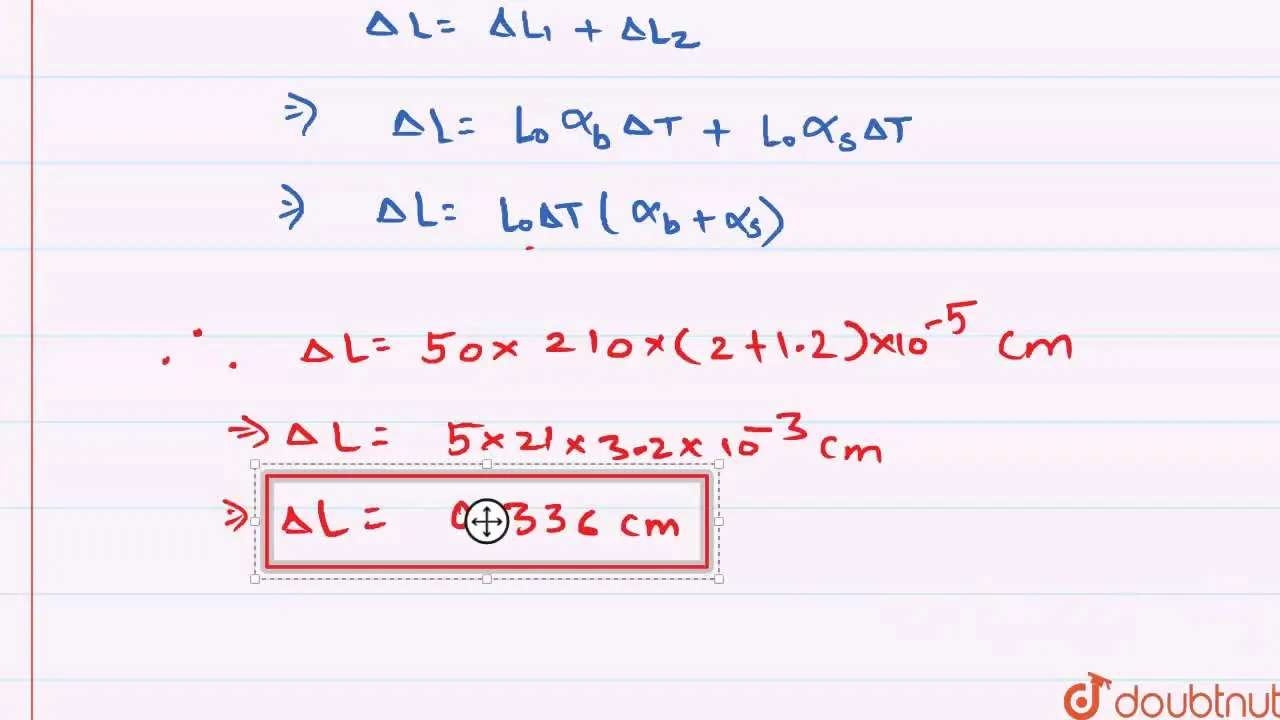A brass rod of length 50cm and diameter 3.0cm is joined to a steel rod of the same length and diameter. What is the change in length of the combined rod at 250∘C, if the original length are at 40.0∘C?
(Coefficient of linear expansion of brass =2.0×10−5/∘C,steel=1.2×10−5/∘C
Initial temperature, T1=40∘C
Final temperature, T2=250∘C
Change in temperature, ΔT = T2–T1=210∘C
Length of the brass rod at T1,l1=50cm
Diameter of the brass rod atT1,d1=3.0mm
Length of the steel rod at T2,l2=50cm
Diameter of the steel rod at T2,d2=3.0mm
Coefficient of linear expansion of brass, α1=2.0×10–5K–1
Coefficient of linear expansion of steel, α2=1.2×10–5K–1
For the expansion in the brass rod, we have:
Change in length(Δl1)Original length (l1)=a1ΔT
∴Δl1=50×(2.1×10−5)×210
=0.2205 cm
For the expansion in the steel rod, we have:
Change in length(Δl2)Original length (l2)=a2ΔT
∴Δl2=50×(2.1×10−5)×210
=0.126cm
Total change in the lengths of brass and steel,
Δl=Δl1+Δl2
=0.2205+0.126
=0.346cm
Total change in the length of the combined rod =0.346cm
Since the rod expands freely from both ends, no thermal stress is developed at the junction.
Related Playlists
- BOOK - NCERT ENGLISHCHAPTER - THERMAL PROPERTIES OF MATTEREXERCISE - EXERCISE22videos
THERMAL PROPERTIES OF MATTER
- BOOK - NCERT ENGLISHCHAPTER - SYSTEMS OF PARTICLES AND ROTATIONAL MOTIONEXERCISE - EXERCISE33videos
SYSTEMS OF PARTICLES AND ROTATIONAL MOTION
- BOOK - NCERT ENGLISHCHAPTER - THERMODYNAMICSEXERCISE - EXERCISE10videos
THERMODYNAMICS
Similar Questions
At 50∘C , a brass rod has a length 50 cm and a diameter 2 mm . It is joined to a steel rod of the same length and diameter at the same temperature . The change in the length of the composite rod when it is heated to 250∘C is (Coefficient of linear expansion of brass = 2.0×10−5∘C−1 , coefficient of linear expansion of steel = 1.2×10−5∘C−1)
View SolutionA brass scale is graduated at 10∘C. What is the true length of a zinc rod which measures 60.00 cm on this scale at 30∘C?
Coefficient of linear expansion of brass=18×10−6K−1.View SolutionA steel tape 1m long is correctly calibrated for a temperature of 27∘C. The length of a steel rod measured by this tape is found to be 63.0cm on a hot day when the temperature is 45.0∘C. What is the acutual length of the steel rod on that day? what is the length of the same steel rod on a day when the temperature is 27.0∘C ? coefficient of linear expansion of steel =1.20×10−5.∘C−1.
View SolutionOn heating the metal rod of length 2m from 0°C to 50°C, its length is increased by 0.1 cm. the coeffecient of linear expansion of metal rod is
View SolutionWhat should be the sum of lengths of an aluminium and steel rod at 0∘C is, so that all the temperature their difference in length is 0.25m. (Take coefficient of linear expansion for aluminium and steel at 0∘C as 22×10−6/.∘C and 11×10−5/.∘C respectively.)
View SolutionA steel rod of length 1m is heated from 25∘to75∘C keeping its length constant. The longitudinal strain developed in the rod is ( Given, coefficient of linear expansion of steel = 12×10−6/∘C).
View SolutionDetermine the lengths of an iron rod and copper ruler at 0∘ C if the difference in their lengths at 50∘C and 450∘C is the same and is equal to 2 cm. the coefficient of linear expansion of iron=12×10−6/K and that of copper=17×10−6/K.
View SolutionDetermine the lengths of an iron rod and copper ruler at 0∘ C if the difference in their lengths at 50∘C and 450∘C is the same and is equal to 2 cm. the coefficient of linear expansion of iron=12×10−6/K and that of copper=17×10−6/K.
View SolutionA steel rod is clamped at its two ends and rests on a fixed horizontal base. The rod is unstrained at 20∘C. Find the longitudinal strain developed in the rod if the temperature rises to 50∘C. Coefficient of linear expansion of steel =1.2×10−5C−1.
View SolutionA steel rod is clamped at its two ends and rests on a fixes horizontal base. The rod is unstrained at 20∘C. Find the longitudinal strain developed in the rod if the temperature rises to 50∘C. Coefficient of linear expansion of steel =1.2×10−5∘C−1.
View Solution


